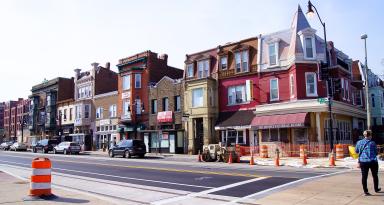

Photo by Katelyn Warner on Unsplash
The Housing Affordability Crisis in D.C.
Currently, the median sale price for a home is approximately $639,000 in the District, according to Realtor.com, and much of the surrounding suburban area isn’t much lower, with median prices reaching $630,000 in Arlington County, Va.; $565,000 in Fairfax County, Va.; and $500,000 in Montgomery County, Md. (Prince Georges County, Md., with a median price of $385,000, is an exception to the pattern.)
Although the region’s average annual personal income of nearly $73,000 is well above the national average, according to Bureau of Labor Statistics data, it’s still difficult for area residents to find an affordable home — which is defined by the federal government as costing no more than 30% of a person’s pre-tax income, including mortgage or rental payments as well as utilities. Many people end up spending half or more of their incomes on their housing, according to Peter Tatian, a senior fellow and research director at the Urban Institute, a Washington-based nonprofit research organization.
The problem has the potential to get even worse, according to the Urban Institute’s 2019 study, which found that the region will need 374,000 new homes by 2030, based on expected economic growth — and possibly even more, if the local economy surges even faster. About 40% of those new units will need to be in a price range that workers with moderate incomes can afford. The report concluded that without action, housing shortages and rising prices could pose a threat to the Washington area’s prosperity, by making it tough for businesses to find and keep workers, and possibly even by discouraging companies from locating here.
“People in the middle incomes are now competing with higher-income people for some of the same housing,” Tatian explains. “They may have a challenge finding moderately priced units because they get outcompeted. I think that speaks to the general supply challenge. We need more housing in more places, and for various income levels.”
The housing situation is even tougher for low-income residents, whose incomes are 80% or less of the median income for the area. The 2019 Urban Institute study found that there were 264,000 fewer affordable units than needed in that price range.
We need more housing in more places, and for various income levels.
On the plus side, affordable housing activists say that local governments have been working hard to increase the supply of affordable housing. Stephen Glaude, president and CEO of the Washington-based Coalition for Nonprofit Housing & Economic Development, says that the District under Mayor Muriel Bowser has become a leader in affordable housing creation, with its plan to create 36,000 new housing units by 2025, locating a third of those in low-income neighborhoods. (More than half of those units already have been created, according to the District government’s housing dashboard.) Since 2015, the District has invested nearly $1 billion through the Housing Production Trust Fund, which provides loans, grants, advice and technical assistance to developers. In exchange, developers agree to covenants that keep housing prices affordable for low- and moderate-income households.
Eliana Golding, a policy analyst at the DC Fiscal Policy Institute, says the District needs to go even further. “DC’s rent control law only covers about 90,000 households, and the supply of rent-controlled units is shrinking every year because the law doesn’t allow any rent-controlled units to be added,” she explains. “Lawmakers should expand rent control to protect more tenants, close loopholes in the existing law to prevent the loss of affordable housing, and keep rent-controlled housing affordable for current tenants.”
In the suburbs, county governments are working to create affordable housing as well. In Arlington County, the local government offers direct housing subsidies to thousands of low-income residents and has also funded affordable housing creation. In 2021 the county provided a $150 million loan to help a developer acquire the 1,334-unit Barcroft Apartments complex. The county loan, coupled with a $160 million loan from the Amazon Housing Equity Fund, ensures that the apartments will remain affordable for 99 years.
“We also produce affordable housing through various provisions in our zoning ordinance, which offer greater density in exchange for some affordable housing,” explains Anne Venezia, the county’s housing director. “More than 300 affordable units were produced over the past five years.”
In Fairfax, Tom Fleetwood, the county’s Housing and Community Development director, reports that the Workforce Dwelling Unit program, which has created 1,700 units of moderate-income housing since 2007, has been amended to produce more housing for lower-income households as well. The county is using “every tool at its disposal,” Fleetwood says, to increase the supply of affordable housing, from investing directly in private developers’ projects to making county-owned vacant land available for affordable housing development.
Montgomery County is working to create new affordable housing to meet a projected need of 40,000 more units by 2030. In addition, in 2021 the county created the Affordable Housing Opportunity Fund, which provides developers with financing to acquire and preserve the area’s existing 25,000 affordable housing units. Without that intervention, explains Frank Demarais, deputy director of the Department of Housing and Community Affairs, planners estimate that the county might lose 7,000 to 11,000 of those units by 2030.
Looking beyond the next decade, continued economic growth and the ever-increasing popularity of the Washington, D.C. area seem likely to continue pushing housing costs upward. But local government, policy analysts, nonprofit organizations and other advocates have the opportunity to watch and learn which of the many solutions currently being implemented might offer the best path forward for the future.
Last Updated: April 28, 2022

